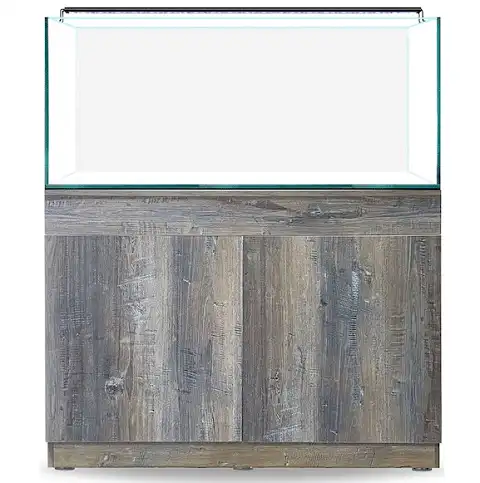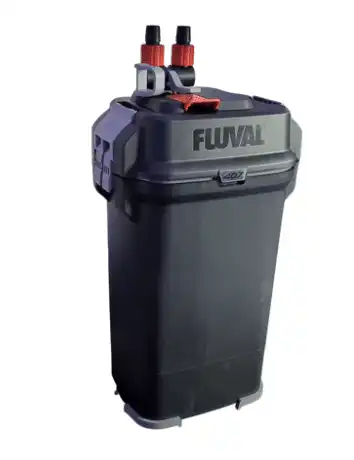Thank you for visiting! By the way… any links on this page that lead to products on Amazon and other stores/partners are affiliate links Aquarium Store Depot earns a commission if you make a purchase.
Welcome to our aquarium blog, fellow fishkeeper 🐟!
Have you seen a Discus fish and wished you could own them, but concerned about its sensitivity? There is a fish out there that looks just as good, gets just as large, and is pretty hardy.
That fish is called the Severum Cichlid, and while it is called the poor person’s Cichlid in the hobby – I would call it the sensible aquarist’s Cichlid.
While these fish are relatively mellow, they get large and have certain tank requirements, and are limited in the type of tankmates you can keep. With the knowledge tidbits I’ll offer today, you will be ready to embark on keeping your first Severum successfully.
Let’s learn all we can about this beautiful fish. Time to dive in!
Key Takeaways
- Severum cichlids are large, docile, and wonderful species to introduce to a home tank
- They are one of the very few Cichlid species that are partial vegetarians and frugivores
- They are beginner-friendly and do well in a variety of tank conditions
- While their temperament is on the peaceful side, they may eat fish that fit in their mouths
An Overview
| Scientific Name | Heros severus |
| Common Names | Severum Cichlid, Banded Cichlid, Rainbow Severum Cichlid |
| Family | Cichlidae |
| Origin | Orinoco and upper Rio Negro basins, South America |
| Diet | Omnivore |
| Care Level | Moderate |
| Activity | Active |
| Lifespan | 7 to 10 years |
| Temperament | Semi-aggressive |
| Tank Level | Bottom and mid |
| Minimum Tank Size | 55 gallons |
| Temperature Range | 75 F° to 84 F° |
| Water Hardness | 4 to 6 dH |
| pH Range | 6.0 to 7.5 |
| Filtration/Water Flow | Low |
| Water Type | Freshwater |
| Breeding | Egg-layers |
| Difficulty to Breed | Easy |
| Compatibility | Community tanks (with large enough fish) |
| OK, for Planted Tanks? | With Caution |
What Is A Severum Cichlid
Severum Cichlids have been in the aquarium hobby since the 1800s1 and the reasons are apparent: their pleasant personalities, large size, and unique and attractive color patterns have made them very popular to aquarists.
These freshwater fish species are scientifically named Heros Severus while commonly known as Severum Cichlids, Rainbow Severum Cichlids, and Banded Cichlids.
Apart from adding a diversity of colors to your aquarium, these fish can are one of the rare large fish that can actually be considered community fish (as long as the fish housed aren’t small enough to fit their mouths)
Origin And Habitat
Severum Cichlids, also labeled as a Poor Man’s Discus, hail from the upper Orinoco and upper Rio Negro Basins in South America.
They were first sighted in the 1800s by an Austrian zoologist and ichthyologist named Johann Jakob Heckel. In their natural habitat, they inhabit slow-moving and vegetated areas with underwater trees and plants.
Appearance
Finding a fish that exhibits a beautiful spectrum of unique colors and patterns, pleasant personality traits, and the ability to bring liveliness to a traditional home aquarium is not impossible anymore.
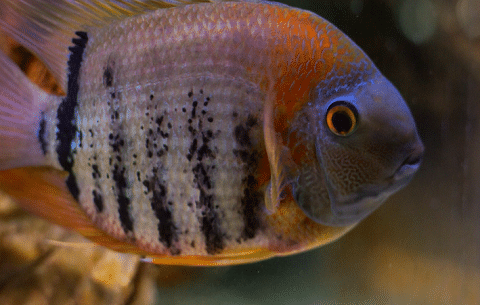
Severum Cichlids fit well in the showcase fish role. These Cichlid Fish come in different varieties, and each variety has a special color pattern that helps it stand out.
Generally, Severum Cichlids have large oval-shaped compressed bodies with a golden hue dispersed over their entire frames. These bands are visible along the sides and are more vivid in juveniles. Adult Severum Cichlids feature duller stripes. The fry feature consistent gold colors that become flecked with burnt orange spots across a large part of their bodies and fins. There are almost 8 bands present on their bodies, which go dull as the fish ages.
But awkwardly enough, noticing these bands in fry is hard. You can only see that clearly once the juveniles hit maturity.
Severum Cichlids feature sharp anal and dorsal fins that look rather yellow. Their pectoral fins also look pointed. The first set of fins narrows down to a striking point. And in most fish, these fins extend past the caudal fin, giving them a round-shaped look.
Apart from yellow dorsal fins, they have yellow eyes and beautiful tails with a combination of a white base and specks of yellow.
These fish are sold in fish sizes when they are small, but they can grow to an impressive size if you properly look after them.
Since there are different types, it can be slightly hard to recognize the original one. To identify which one is real, look at the greenish-hued body combined with a golden-yellow underbelly. Nowadays, you can see alternations in their color patterns that are obtained by home breeding.
These fish are well-known for their subtle orange. These fish tend to get more intense in color as they mature.
Depending on what species you have, you can expect to see changed color morphs, as well as stripes. Some fish have large and vertical stripes, while others only exhibit extremely contrasting spots that sit perfectly with their yellowish-golden base.
And unlike African and South American Cichlids, Severum Cichlids look flattened and are tall with a vertically rounded shape. The reason they are called poor man’s discus lies in the fact that they mimic the profile of the more pricey discus fish.
To differentiate males from females, look at the size and markings on their gills. The male Severum Cichlid is usually larger and may develop a nuchal hump and extensions to its anal and dorsal fins. This makes the overall appearance more prominent compared to the female Severum.
Another difference between males and females is the dark spot visible on the female’s dorsal fin. Females also lack patterning on their heads.
Now it’s time to talk about the five most common varieties of Severum Cichlids!
5 Common Varieties
In the aquarium hobby, there are different types of Severum Cichlids. Introducing any type to your tank can be a good change from the wild Severum Cichlids that have subdued colored bodies.
Heros Severus
This type of Severum Cichlid is the most recognized compared to others. It has yellow and golden spots, a flat body with pointed dorsal fins, and a tail. They sometimes feature dark stripes down their length and make a beautiful addition to dull aquariums.

These fish can be semi-aggressive around some specific species. Usually, they do well in a community tank, so make sure you select the right tank mates for them (we discuss tankmates later in this post).
Heros efasciatus
Heros efasciatus, Redhead Severum, or Red Shoulder Severum are the same fish. This type isn’t as common , but it is incredibly beautiful in its own right. They feature a golden base and bright red spots behind their gill covers, and a vibrant green color as well.

They are usually available as wild-caught, which makes them more sensitive to tank-bred species. Because they are in high demand, they command a high price tag at the local fish store.
Heros liberifer
Fish of this type feature a plain glistening white base that can sometimes look red or orange.
They have prominent horizontal deep black stripes. Unlike Heros Severus, they are more aggressive and can give a tough time to their tank mates.
Heros spurius
This type of Severum Cichlid is duller than the others mentioned previously. They have hues and stripes visible all across their bodies, including their fins and tails. They can grow up to 7 inches in length.
Heros Notatus
You can find different color varieties with this type of Severum Cichlid. They can be purple, orange, green, and yellow. They are known for their spotted bodies. This Severum Cichlid has spots all over their bodies, fins, and tails.
Author's Note: Green Severum Cichlids are the most common and easily found type in pet stores. The Gold variety is the second most common type of Severum Cichlids found in the aquarium trade.
Lifespan
The average lifespan of a Severum Cichlid is around 5 years. With proper care, they can live as long as 10 years in an aquarium.
This makes them a perfect pet for those fish owners who want to spend more time with their pets and establish a stronger connection with their aquatic friends.
Average Size
The Severum Cichlid is known to grow to an impressive size both in the wild and in a home tank.
The Severum Cichlid can go as large as 8 inches. You need to focus on its diet, tank conditions, water quality, and what type of tank mates it has around it to ensure healthy growth. It might suffer from stunted growth as a result of stress. So, ensure there’s nothing in the tank that can stress your pet out.
Care
Severum Cichlid care is actually pretty basic compared to other large fish species. If you’re an ambitious beginner, and you understand their temperament, and what things fit them best in a home tank, you can have a great experience with them.
The Severum Cichlid is a hardy fish capable of adapting to harsh conditions in the wild. Some fish cannot survive what they can peacefully put up with. But it doesn’t mean you should ignore regular maintenance and a proper tank setup.
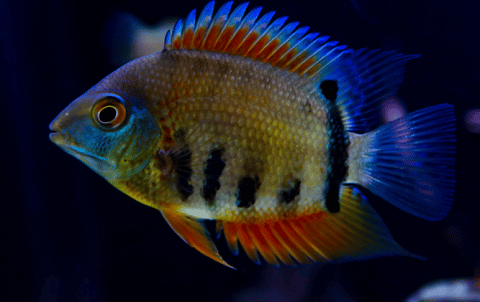
The Severum Cichlid is typically a peaceful fish. Unlike other Cichlid species that can fight to the death over food or maintain control over their territory, they remain relatively calm.
However, they can act potentially aggressively around other fish. It can be territorial aggression or the overwhelming effect of attacking the smaller fish. Once they show aggression or signs of stress, make sure you separate them from the cause of stress. The Severum Cichlid can fall prey to diseases because of high levels of stress.
Providing good care and a safe environment will create a strong preventive shield from diseases.
Aquarium Setup
Severum Cichlids get large and need an appropriately sized home to make themselves comfortable. A large environment with clean water will help stress low and your fish healthy.
When it comes to setting up an aquarium, you should think about the Severums habitat in the wild. These fish come from murky waters that have low water flow. Knowing this, we do not want high water flow for our gentle giants. They are surface swimmers, so open space is ideal for them.
Open space will get them to swim around, and a large space will keep aggression down. These fish, which gentle in nature can get territorial. A crowded tank will lead to disputes and fighting. Rocks are preferred over driftwood as these fish like to dig. They will stay active throughout the day.
Tank Size
Severum Cichlids don’t grow overnight. But while setting up their tank, considering their growth rate can help decide the size of the tank. Usually, a 55-gallon tank does best for a Severum Cichlid. Feel free to get a larger tank because it’s always better to invest in a spacious tank for your pet.
Current's Serene line offers a unique opportunity for Freshwater Aquarists. Comes with a filter, stand, light. You can even pick an aquascaping package!
Baby Severum Cichlids grow half an inch a month. Once they get to a certain size, you will see a decline in their growth rate. It takes them 2 years to become 8 inches long. Depending on the number of species you have, you can go for a 70-100 gallon tank for fully grown Severum Cichlids and other fish of similar size.
Water Parameters
Severum Cichlids live in tropical water areas of South America. To provide them with the healthiest environment, maintaining the right water parameters is necessary.
Keep the water temperature between 75 F° to 85 F°. Anything below this range might stress out your pet. The range can vary if you want to breed your fish though.
For pH, keep it between 6.0 to 7.0. Make sure pH levels remain stable. Any drastic changes can harm your fish. As for water hardness, I recommend staying between 4 to 15 dGH.
Filtration and Aeration
Facilitating regular water changes is a great way to maintain a healthy tank environment.
A freshwater tank can accumulate several nutrients from waste, such as nitrites, nitrates, and ammonia. Fish waste will contaminate your water quality.
It’s better to make regular water changes of up to 20% to ensure a healthy environment. You can also use a high-quality canister or hang-on-back filter to keep the water well-oxygenated.
Author's Note: Severum Banded Cichlids often gasp for air at the surface when the oxygen levels are low. This often leads to high levels of distress in the fish. If your fish constantly repeats it, it's time to clean out the aquarium water.
Lighting
Lighting is not an issue when it comes to Severum Cichlids. They mostly stay active throughout the day and rest throughout the night. A mild exposure to natural lighting is great. You can also use light LED lights to monitor their activities or to enhance their appearance.
Aquatic Plants And Decoration
Designing the interior of your Severum Cichlid freshwater tank is one of the most enjoyable aspects of the aquarium hobby.
In the wild, they thrive in highly vegetated water and use plenty of hiding spaces to rest in.
While designing their tank, you can use different live plants, plastic caves, and castle accessories. Adding driftwood and rock formations are also some good choices.
This way, your fish will stay busy exploring different things and feeling at home.
While the Severum Cichlid needs hideouts, it can be problematic for you to keep the decorative items in place. They have a tendency to dig below decorations. It is recommended to have them set at the tank glass bottom, so they don’t topple over if dug up.
Live plants are a major challenge with Severums. While many guides you will find online will tell you there are some plants like Anubias and Hornwort that can survive, our experience tells us that this is typically not the case. Severums are best kept with aquarium rocks over live plants.
Tank Maintenance
Regular tank maintenance holds great value for the well-being of Severum Cichlid.
Cichlids produce chunks of bioload. Apart from getting a good-sized canister filter, you should clean the tank every now and again to keep decorative items, the tank, and the underwater environment clean.
Our Subscriber's Choice
Top name brand, Italian made, and updated design. The next gen Fluval Canisters are a best buy!
Here are some tank-cleaning tips to get you started:
- Occasionally trim the plants and remove plant material from the tank.
- Use aquarium water and a clean toothbrush to wash caves and other decorative items
- Use an algae scrapper to clean off algae from the tank walls.
Substrate
Severum Cichlids tend to dig around a lot. They love to create hills and pits by moving sand. You don’t have to be too creative with layering the base since they will redecorate it anyway.
I recommend using a fine sand substrate for the Severum tank. You can also use a little bit bigger grains but don’t good too large on the gravel as large gravel can injure these fish when they try to dig
Pro Tip: In community tanks that need softer water. You can layer the top of the substrate. You can use Indian almond leaves or small clumps of peat moss. This will benefit water conditions. Using leaves will also help create the effect of their natural habitat. Also, make regular replacements as the debris deteriorates.
Community Tank Mates
Placing your Severum Cichlid with the right kind of tank mates will help in the long run. No beginner can afford frequent conflicts among fish. Not only that, incompatible tank mates can turn a healthy fish into a stressed one.
Severum Cichlids are generally peaceful. But they habitually love colonizing the entire tank. You can prevent this by creating necessary barriers within the tank without curtailing their land and freedom to roam around.
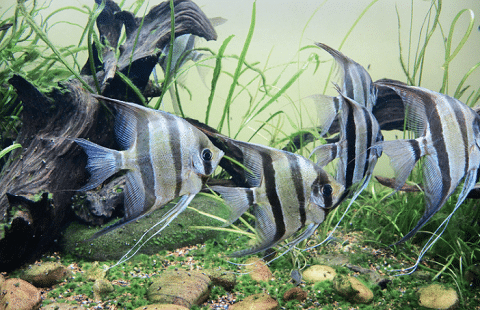
For a Severum Cichlid tank, you should look for medium or larger mellow fish species that can make compatible tank mates.
Here’s a list of some of the best species to consider.
- Barbs
- Angelfish
- Blue Acara
- Catfish
- Pearl Cichlid
- Blue Gouramis
- Gold Gourami
- Moonlight Gouramis
- Flag Cichlid
- Blood Parrot Cichlid
- Loaches
- Silver Dollars
- Oscar Fish (most cases)
- Pleco Fish
- Silver Dollars
Poor Tank Mates
Avoid larger and more aggressive fish species to pair up with Severum Cichlids. These aggressive tank mates should never be kept in the same tank as your Severum Cichlid.
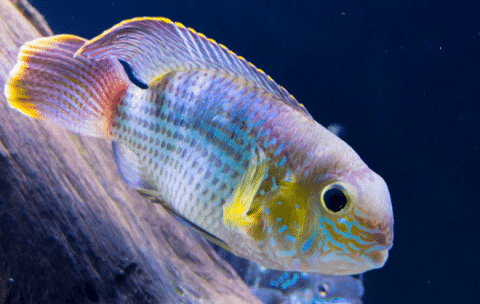
Unlike other Cichlid species, Severum Cichlids don’t realize they have the ability to defend themselves. Avoid these other species when it comes to Banded Cichlid tank mates:
- All large New World Cichlid species
- Small Gouramis like Dwarf and Honey Gouramis
- Freshwater Shrimp
- Aquarium Snails
Breeding
Breeding Cichlids is a wonderful experience as these fish will breed in pairs and will care for their fry. In order to pull it off, you will need to start up with several juvenile fish – at least to start out. They will need to grow up together until you see a couple pair up. That is your sign that a breeding pair is forming
However, these Severum Cichlids are selective about who they decided to breed with. Keep them together and hope that they bond. It will usually take up to 6 months for cichlids to go from juveniles to forming as a pair. You will need to be patient and understand that this takes time.
Once you have a breed, it’s time to set up the environment. Here is what you need to do:
- Obtain a separate tank to use for breeding the pair.
- Set the temperature higher – 78 – 81 degrees F to be exact
- Keep plenty of decor and hiding plants for comfort
- Feed the fish a well-balanced diet. A healthy fish will actively breed, so diet is key
Once the pair do their thing, the eggs will hatch in about a week. Both parents will watch over the eggs and raise the fry together. Work with crushed flake food to feed the fry or use enriched hatch brine shrimp.
Food and Diet
The Severum Banded Cichlid is an omnivore. They are hardly picky and, therefore, will feast on anything you drop in their tank.
To spice up their menu, feel free to go for high-quality herbivore and carnivore flakes.
You can also feed them pellets, micro worms, earthworms, bloodworms, marine crustaceans, white mosquito larvae, brine shrimp, green vegetables, and even fruit.
Don’t feed your pet beef heart or liver as they have fragile digestive systems and can fall ill from it.
Common Health Problems
Like any other fish, Common Severum Cichlid species can also fall prey to different diseases. You should always keep an eye out for common symptoms so that you can treat them on time.
Here are some common diseases Severum Cichlids are susceptible to.
Head and Lateral Line Erosion (HLLE)
This disease is common in fish species raised in tanks with poor water quality. Other common reasons can be over-filtration with toxic chemicals, stress, vitamin deficiency, and poor diet.
The most common symptom of this disease is a hole in the head of the fish
It begins as small pits of receding skin around the fish’s head and lateral line and sometimes occurs on the unpaired fins. To treat this, simply isolate your pet, get water conditions fixed and supplement its diet with vitamin C, calcium, and phosphorus.
Ich
Ich is a very common fish disease. The presence of an external protozoan parasite typically causes this infection.
Some common symptoms are:
- Multiple small white spots on the fish’s body and gills
- Frequent scrapping of the body against hard objects
- Abnormal behavior
FAQs
Is Severum a hardy fish?
Yes, Severum cichlids are very hardy. They can withstand harsh environmental conditions but still need proper tank conditions to thrive. If they are properly looked after, they can provide you with enjoyment for a very long time.
Can Oscars and severums live together?
Severum Cichlids are semi-aggressive. Some species can be on the more aggressive side, while others stay pretty composed. But their large size and toughness allow them to stand up to an Oscar. The behavior Severum Cichlids display in a tank shared with an Oscar is usually not problematic. But make sure there is no aggression from the other side as well.
Closing Thoughts
I hope you learned a lot about Severums from our article. They are an underrated fish, and in my opinion, the label of poor person’s cichlid doesn’t jive well with me. They stand on their own in an aquarium and make a settler showcase fish. Their gentle nature makes them one of the rare large fish that will tolerate tank mates and is hardy. Give them a chance, and they will shine and give you many years of joy.
Have you kept Severums in the past? Let us know in the comments. Until next time!
- About the Author
- Latest Posts
I’m thrilled that you found Aquarium Store Depot! Here you’ll find information on fish, aquariums, and all things aquatics related. I’m a hobbyist (being doing this since I was 11) and here to help other hobbyists thrive with their aquariums! I adhere to a high quality Editorial Process and Review products with real life field usage and practical analysis.


